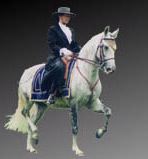 |
classicaldressagescotland.com |
| Lesson 8: Balance, Engagement and the Half-halt |
| New web address: www.classicaldressagescotland.com |  |
| About this site | About us | Personal Tuition | Video analysis | Lesson menu | Portugal and Lusitanos |
| Home Schooling Classical dressage Modern dressage Horse trials Show jumping Glossary Links |
I was chatting to one of my clients just a
few days ago and we were discussing the various differences between the types
of horses that are recognized as a good horse to train for pure dressage;
Warmblood, Iberian, Lipizana and so on. She asked me that if I had a choice of
any horse with unlimited funds, what breed would I go for? Without much thought
I replied that at the end of the day, I really couldn't care less what breed
the horse was, just so long as the animal went forward. The reason I said that
without thinking was that without that urge to go forward from the leg, to be a
forward thinker, the half halts which are the cornerstone of balance,
engagement and preparation for a turn or transition just would not be
effective.
Let me put that response to my client's question into perspective. If I were riding, for example, a Prix St George dressage test with about 35 to 40 movements, I would probably be asking for some sort of half halt about 70 to 80 times during the test. If I rode this number of half halts without the horse being in front of my leg or not going forward, the stewards would have to carry me off the arena on a stretcher suffering from exhaustion and then plug me into a very large oxygen cylinder. Between the equine partner and myself there is only going to be one sweaty blob leaving the arena, and that ain't going to be me! As we have discussed in previous lessons. The horse's natural stance or balance is on the forehand, with most of his weight over the front legs. Your job as the rider is rebalance the horse back onto the hind quarters and engage the most powerful part of the horse, the hind legs and quarters. This is where the half halt or half parade is used. You will notice that I am still not mentioning collection. The re-balancing or engagement of the hindquarters is just another part of preparation for collection. Collection, the principles of collection and how to achieve collection will be the subject of several lessons in the future. It ís a huge, misunderstood and misquoted subject. Now back to engagement, balance and the half halt. This way of visualizing the gathering up, the closing together and engagement of the horse was taught to me by Herr Kalman de Jarenak of the Hanovarian Society in Germany. 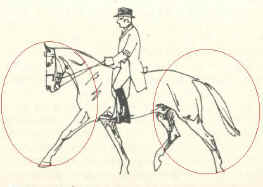
Imagine that there are two circles. When the horse is long, not gathered but is on the aids, the circles are apart. One circle encompassing the forehand and second circle around the hindquarters. 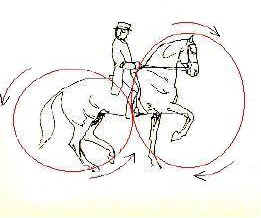
Your job as the dressage rider is to close these circles together: the first coming up through the rider's legs, over the wither, down the front of the horse's face, down under the horse's forelegs and back up through the sole of the rider's boot; and the second circle coming up through the rider's legs, over the horse's rump or quarters, down under the horse's hind legs and back up through the sole of the rider's boots. The hindquarters rotating under the horse's balance, under the horse's center of effort driving forwards and the forehand rotating upwards, lightening the horse's shoulders and leaving the forelegs freedom to swing with extravagance and without effort. 
If both hind legs step further forward under the horse's center of effort, the quarters with bent haunches will carry more weight and then propel the body powerfully forwards and upwards. Because the center of effort is shifted back and the quarters carry more weight, the forehand is lightened and elevated, the horse's neck is arched and elegant and the back round and soft. The feeling you should get as the rider is that, once you thought you owned a Lada but now you own and ride a Rolls Royce. Now we have balanced and engaged the horse, you must remember that the half-halt or half-parade still has another magic effect that you will find extremely useful, especially when competing. The half halt is also used to bring the horse to attention. To prepare him for things to come. To make your horse aware that something is about to happen. In the arena, or training manege, you should be the only part of the team that knows what's happening or where you are going. Nothing breaks the confidence or concentration of a horse more effectively than not bothering to prepare him for a circle or a corner. Your horse is taken by surprise, and goes into self-preservation mode when he sees the wall looming up in front of him, and you will then have to yank the rein to turn him just before the wall or the boards. OK that's enough of the theory, now lets start by giving you a few pointers as to how to ride the half halts or half parades. Think of the exercise, the aids, not necessarily what you do with your seat legs and hands, but the end result, the cause and effect. For example, there are dozens of ways to gather your horse, to balance him, to bring him to attention. It could be as dramatic as extended trot back to two or three steps of piaffe, then back to extended trot or it could be merely a little taking of the rein to increase bend or to loosen the horse's jaw. It really depends on the situation you are in and what would be appropriate for your horse at that moment in time. The most common and perhaps the most useful aid to half halt is to close the legs to ask for more forward impulsion/energy. Close the fingers on the reins to block, so that the horse gathers himself, not go faster or run away or drop down onto his forehand. To round his back, lift the forehand and step though from behind. 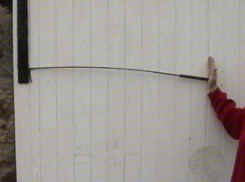
Think of the exercise as illustrated with an ordinary whip in the pictures opposite. Eleanor is holding the whip against a solid object, in this case my hay barn door hanger. Obviously the door hanger cannot move backwards. It ís a solid object, it can only ìfixî. In the second picture, Eleanor has pushed with the flat of her hand against the whip handle and the whip has shortened, become round or if you like gathered up. What ís really important about this illustration is to note that the door hanger cannot pull back it can only block. 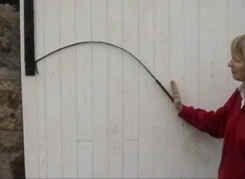
Take this exercise to your horse. Think of the door hanger as your reins, a block to momentarily fix, that cannot pull back, and your legs, the flat of Eleanor's hand pushing towards the front of the whip or into your hand or the bit. These aids should only be applied for a few steps only. Donít keep the pressure on longer than a few seconds. As you feel the horse gather and round his back, back off, soften the rein but don't let your horse fall back onto his forehand. Then, let him go forward into a soft hand. Try not to stitch him up (restrict him). 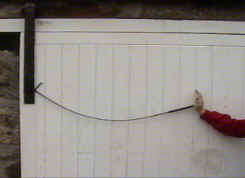
In the third picture you will see that the whip has bent the wrong way. This shape or outline must at all costs be avoided when you ride this exercise on your horse. If you ride the half halts without feeling or are too strong with the aids the horse may hollow his back. You must half halt with finesse and subtleness. If you pull back with the reins your horse will hollow and try to come above the bit. If you grind down with your seat you will be contradicting the messages you are trying to send to your horse. You are trying to bring the horses back up. Ride with a light seat. As your horse learns this lesson you will able to apply the aids with ever-increasing lightness and more finesse so that the half halt can be ridden without anybody being aware of it except you and your teammate. You will also notice that over a period of time, as your horse gets stronger, the paces start to elevate and become more beautiful. This is because you are swapping (exchanging) forward momentum for elevation.
As I said in the beginning of this lesson, there are dozens, even hundreds of ways to ride the half-halt or half-parade. It depends on so many things and situations. It would therefore be impossible for me to explain all the aids and circumstances that dictate what aid to use where and when and what would be the most effective. Please email me, with photographs if you can, giving me more details of how your horse is going and I will get back to you and try and help. To finish, let me quote another great saying from my favorite master, Nuno Oliveira:- Each time the rider forgets to control the cadence, it is the horse who commands And don't forget. If you lose your temper when riding your horse, it is the ultimate confusing aid. Enjoy this month's lesson and get back to me if you are having problems.
|